Saturday, September 30, 2006
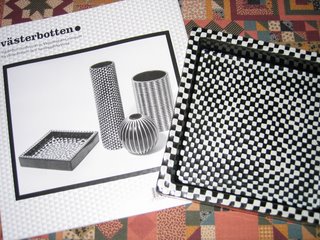 This is still not a design blog - Stig Lindberg
This is still not a design blog - Stig LindbergStig Lindberg was one of the most loved and influential Swedish designers of the 20th century. I grew up in a world where his design was the standard, for example the Domino ashtray shown here, and did not reflect on it or have a distance to it. I just associated this world to the 50's and 60's.
I visited our Nationalmuseum and the exhibition about him and his work. Oddly enough, I was amazed at how many things shown at the exhibition I did not expect to come from him. For example the beautiful, and seemingly un-Lindbergian, Shmoo (Sw: Gnurglor) objects (do you remember the original Shmoo, in Li'l Abner?). And conversely, how many things not shown there that I missed. His very special deck of cards for example, that I used to play with together with the girl next door.
Lindberg has also been celebrated in a thematic issue of the cultural journal Västerbotten in 2005, see the photo.
Read also Klimakteriehäxan's blog (see Favorites), Sept 13, about this exhibition.
Wednesday, September 27, 2006

Valsparaíso
Our host in Valparaíso, Miguel Angel Aldunce, is a fine oud and guitar player, and university music teacher, also sometimes touring in Europe. I brought home a live recording by his group “Sala del espejo”, recorded at an event in the former prison, which at least in 2001 was used for a cultural project.
The group has issued at least one official CD, “Mínimo” (2003) , with partly the same music as on the live recording. It is partly a celebration of the home town, one song actually named Valsparaíso, but also a lament of the war in Kosovo.
The music is well described by Íñigo Díaz on the website La Música Emol: “Un debut discográfico de creaciones colectivas que van en distintas direcciones, señaladas a veces más a veces menos por la instrumentación diversa: un clarinete en plan klezmático, un violín reiterativo, solos jazzísticos, cantos abiertos, percusiones “tradicionales y exóticas”, como ellos mismos lo indican.”
Tuesday, September 26, 2006

Valparaíso -70 and 2001
Francisco Roca and the Narren theatre group made political music theatre in 1975 about pre-coup Chile, which also resulted in the recording of an LP, Valparaíso -70, mostly with Francisco’s own songs.
I did not get to Valparaíso until 2001. This is an exciting city with a very cosmopolitan feeling. The city is built on a number of hills around the harbour, and the parts of the city have a distinct character from the origin of their original inhabitants – English, Croatian or whatever. We were lucky to have a great host and guide, who is an enthusiast and amateur hometown historian. He took us around Valparaíso, finding his way in its labyrinths, making us ride all the 100 year old escalators, which he was documenting for the purpose of making a documentary CD-ROM.
He also took us to the old prison, which was closed down only a few years ago. There we were guided by a former inmate. This was a very scary place, not least considering that it was one of the places used for imprisonment, isolation, and torture of political opponents of the Pinochet government. It was also strange to hear the former inmate tell about the self-organized community of the prisoners – on harsh terms of course, but still leaving some degrees of freedom.

Norrland – the Cheese
My uncle was a salesman in car spare parts, travelling all over Norrland in his Vauxhall Velox. He used to bring food and other things back from his trips. I especially liked the cheeses. So I learned at an early age to cherish the sandwiches with white and brown goats cheese.
I still like these a lot, in particular when combined, on white crisp barley bread. My favourite cheeses come from the Högåsen goat farm, produced by the Danish lady who came here a long time ago, falling in love with the landscape and the peace and quiet of the Norrland inland.
Wednesday, September 20, 2006

Crossroads - Chatwin and García Lorca
In "In Patagonia", chapter 95, Chatwin writes about the poetry of Garcia Lorca. He surprises a ladies underwear salesman at his hotel in Punta Arenas by recognising the first lines of the García Lorca poem “Lament for Ignacio Sanchez Mejias”: “A las cinco de la tarde. Eran las cinco en punto de la tarde…”
Monday, September 18, 2006

Sour food
Saure lunge, or saures lüngerl is in Bavaria sold both canned and in many restaurants. It may seem to be the answer to sour herring or rakefisk but I guess it is rather related to pölsa or haggis, which both can be quite tasty.
Still, I was reluctant to try it so I stuck to pork, beef, and duck.
Saturday, September 16, 2006
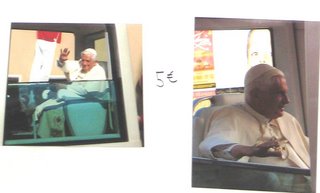
After the Pope
There are no longer t-shirts, scarves and Vatican flags for sale in Freising. The stores now instead sell the stories of the Pope’s visit, and of what he said. In addition you can also buy photograps of the pope in the Papamobile and blessing the town and people of Freising. There is always a market for something!
Coming home again, I see the church towers of the Freising dom on the TV news, and the comments are about muslim protests against the Pope's speech (in Regensburg). This story will probably not end there...
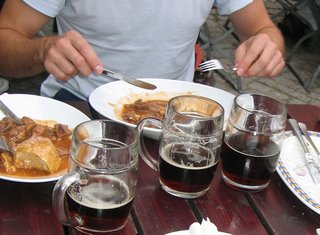
Old beer 2
If not the oldest beer, so at least the oldest beer from a monastery (from 1050), is the Weltenburger Kloster Bier. It comes from an amazing place, the former monastery of Weltenburg – now a first-class tourist target, along the upper parts of the Danube. There is still however a baroque style church and of course the brewery.
Weltenburg can be reached by boat along the river, passing upstream through the Donaudurchbruch, a very scenic ravine which was created when the Danube changed its course many millions of years ago. The monastery yard is now a Biergarten with place for hundreds of people drinking the Weltenburg beer and eating matjes herring, Obatzte (a cheese-based, here beer-seasoned paste), or wild boar gulasch stew (a German invention – in Hungary Gulyas leves is a soup).
Wednesday, September 13, 2006
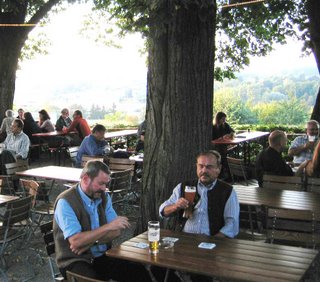 Old beer
Old beerIn Weihenstephan, on the university grounds of Freising, lies the world's oldest brewery still in the business, dating from 1030. Connected with the brewery is also a restaurant with a beer garden, with a nice view of the landscape, and a beer cellar, both for serving food and drink to the guests. The food is excellent at reasonable prices and of course the beer also. My favourite so far is the dark Korbinian, which is a real luxury beer with a big round taste. The best dinner there has so far been the roast duck with blaukraut.
Tuesday, September 12, 2006

Crossing trails 2
Wandering the streets of Freising I find a lot of typical German stores with common household stuff, food, fruits, and books (on the Pope). However in a small street there is also a Salento product store with southern food and wine, bringing back memories of the spring in Apulia. Cheese, biscuits, olive oil and vinegar...
Otherwise the food in Bavaria is something very dfifferent from the Mediterranean - but very good. Roast duck, fried ham, sauerkraut, blaukraut, knödeln in various shapes and origin. And beer - more about that later.
Monday, September 11, 2006

Pope fever
Freising, Bavaria is now in pope fever. The Pope Benedict XVI who once was a student in this town is on official visit to Germany and will come here on Thursday. The town is full with welcome banners and posters, and the bookstores display books by and about him. Unfortunately (?) the Beaver Congress will be on beaver excursion all the day then so we will miss the whole arrangement....on the other hand this event has mostly caused problems with traveling and housing for us.
Wednesday, September 06, 2006
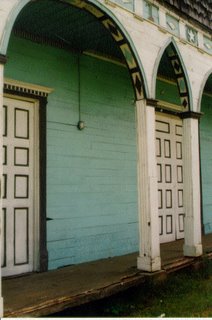 A world heritage
A world heritageApart from the main island Chiloë Grande, there is also a large archipelago in the straits eastwards to the mainland. If Chiloë Grande is peaceful compared to the mainland, the small island of Lemuy is even more so. It is a piece of countryside nostalgy for a Swede, with some wild Fuchsias with colibris added, which doesn't make it worse.
The Chiloë archipelago houses a fantastic UNESCO Cultural World Heritage, its wooden churches. These have a remarkable common stile across sizes, from the big cathedral in Castro, to village churches such as that in Ichuac on Lemuy.
It is only to hope that the World Heritage status makes it easier to fund maintenance for these buildings, which in some cases was badly needed.
Friday, September 01, 2006
 The road to Chiloë, 2001
The road to Chiloë, 2001Chatwin actually wrote no more than four pages, chapter nr 52, about Chiloë in “In Patagonia”, really. This only deals with the Brujería, the feared sect of (male) witches on the island. Somehow, this chapter triggered my wish to visit Chiloë. Afterwards, I was surprised that he had not written a lot more in the book. It seems typical of Chatwin’s writing, that it starts to live its own life in your mind long after reading. How this happens I haven’t figured out. I guess if I had I would be a writer too.
One more influence was an interesting TV film by Francisco Roca about Chiloë. When we were planning a trip to Chile I took a contact again with Francisco after maybe 20 years. He then actually happened to be in Santiago so we met there. We had some good advice for the Chiloë visit and a telephone number to a contact person. This ultimately led us to a very cosy hotel in Ancud, the northernmost town on the island.
What is true at least is that Chiloë is full of legends and tales, which may be the natural thing for an island that was isolated from the rest of the world for two centuries. Lore of the huilliches mixed with that of the colonists and story telling developed to amazing levels.